 Copyright © Michael Richmond.
This work is licensed under a Creative Commons License.
Copyright © Michael Richmond.
This work is licensed under a Creative Commons License.
Structure of the Milky Way
The galaxy in which we live is a relatively large,
but otherwise ordinary,
spiral galaxy.
If we could fly far above it and look down on the
disk,
we might see something like this:

Image of M101 courtesy of
Hubble Image: NASA, ESA, K. Kuntz (JHU), F. Bresolin (University of Hawaii), J. Trauger (Jet Propulsion Lab), J. Mould (NOAO), Y.-H. Chu (University of Illinois, Urbana) and STScI; CFHT Image: Canada-France-Hawaii Telescope/J.-C. Cuillandre/Coelum; NOAO Image: G. Jacoby, B. Bohannan, M. Hanna/NOAO/AURA/NSF
On the other hand,
if we were to fly far away, but in the plane
of the disk,
and take a picture of the Milky Way from the side,
we might see this:
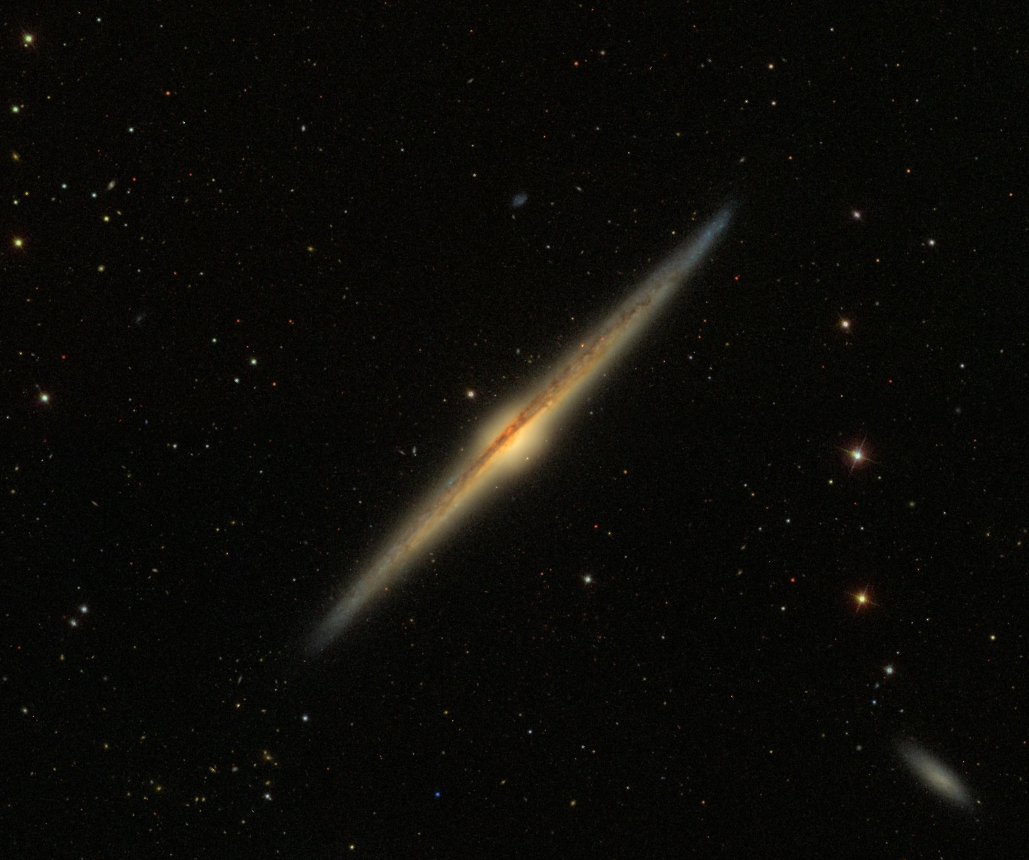
Galaxies are very complicated entities, composed of hundreds of billions
of stars and planets, untold trillions of asteroids and rocks, giant and
not-so-giant clouds of gas and dust, magnetic fields, and a host of
other objects.
In order to simplify our discussion of galaxies,
astronomers often break them down into a few
common pieces.
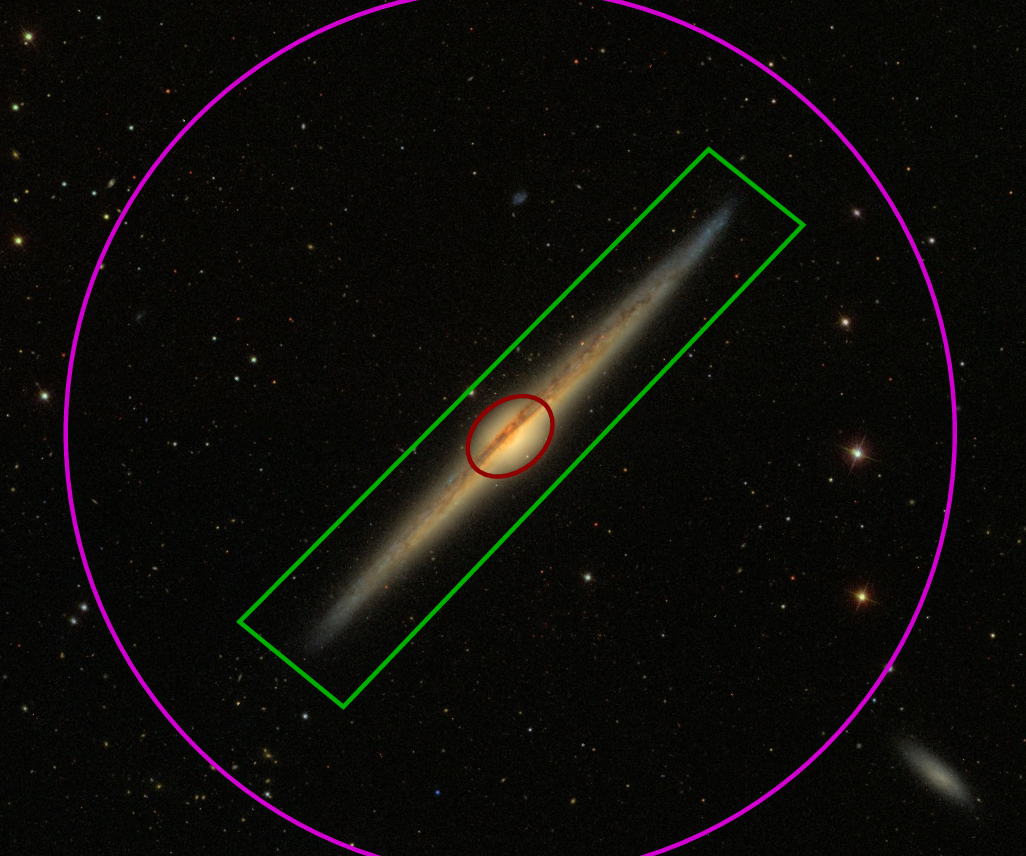
Today, we'll focus mostly on the disk and the bulge;
we'll leave the halo for our next lecture.
Most spiral galaxies feature a central bulge
of roughly spherical shape.
The stars in this bulge are quite different
from the stars in the disk:
bulge stars are
- relatively old (Population II), and, as a result,
- relatively cool and red
- often poor in heavy elements
In theories of galaxy formation,
the bulge is one of the first components
in which stars form.
Some galaxies,
like M104,
have very large bulges.
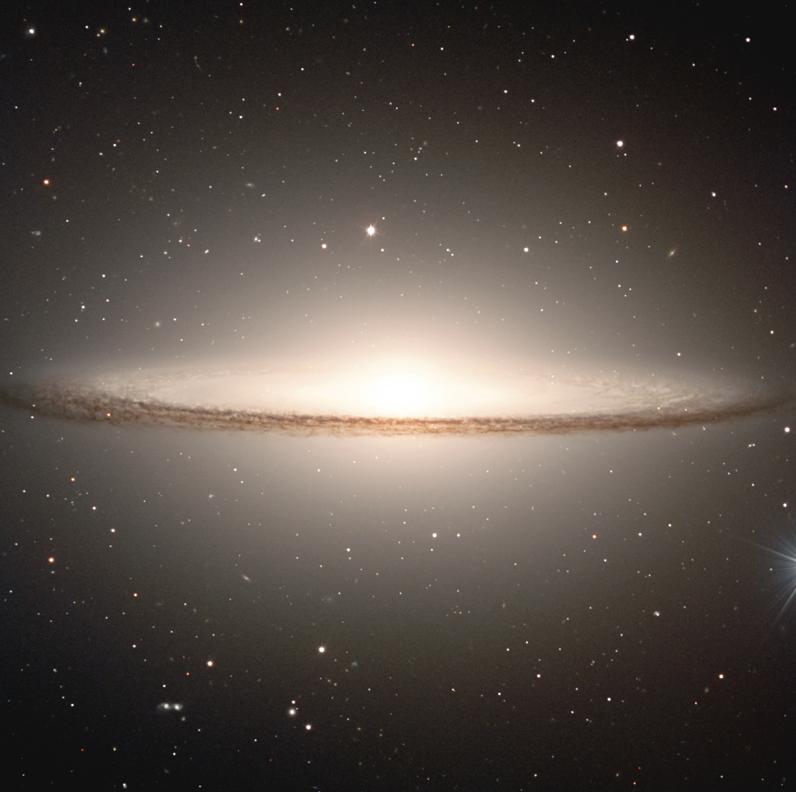
Image courtesy of
ESO/P. Barthel
In others, such as NGC 5907,
the bulge is so small that one can barely see it.

Image courtesy of
Brad Ehrhorn/Adam Block/NOAO/AURA/NSF
The bulge of our Milky Way lies somewhere in the middle.

Image courtesy of
Axel Mellinger and Astronomy Picture of the Day for 2001 Feb 2
Humans have a personal connection to the disk
of our galaxy:
our Sun is one of the members of the
disk population.
The disk is a large, flat collection
of gas and dust,
sprinkled with stars which
- are relatively young (Population I), and, as a result,
- include some massive, blue, very luminous stars
- contain higher concentrations of heavy elements ("metals")
If we look at relatively short wavelengths --
in the optical,
or near-infrared --
we see a flat collection of billions of stars.
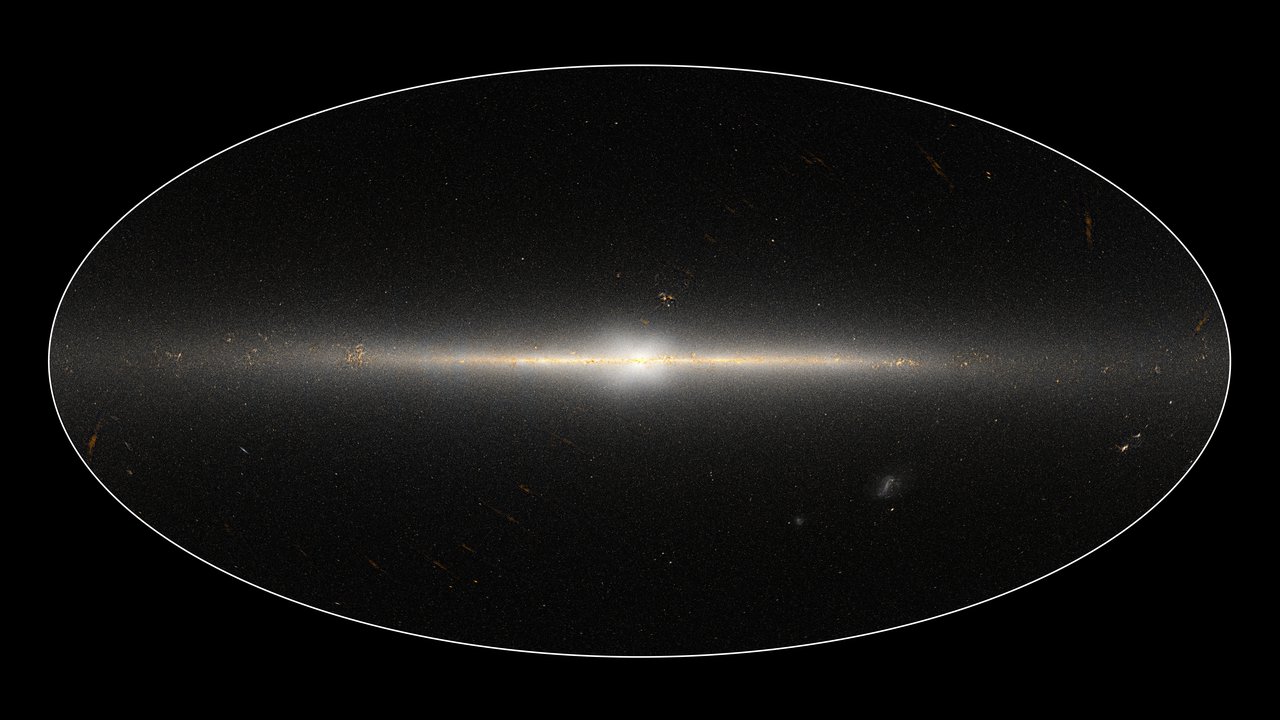
WISE image courtesy of
NASA/JPL-Caltech
But if we look at longer infrared wavelengths,
or in the radio regime,
we see the clouds of gas and dust that permeate this
portion of the Milky Way.
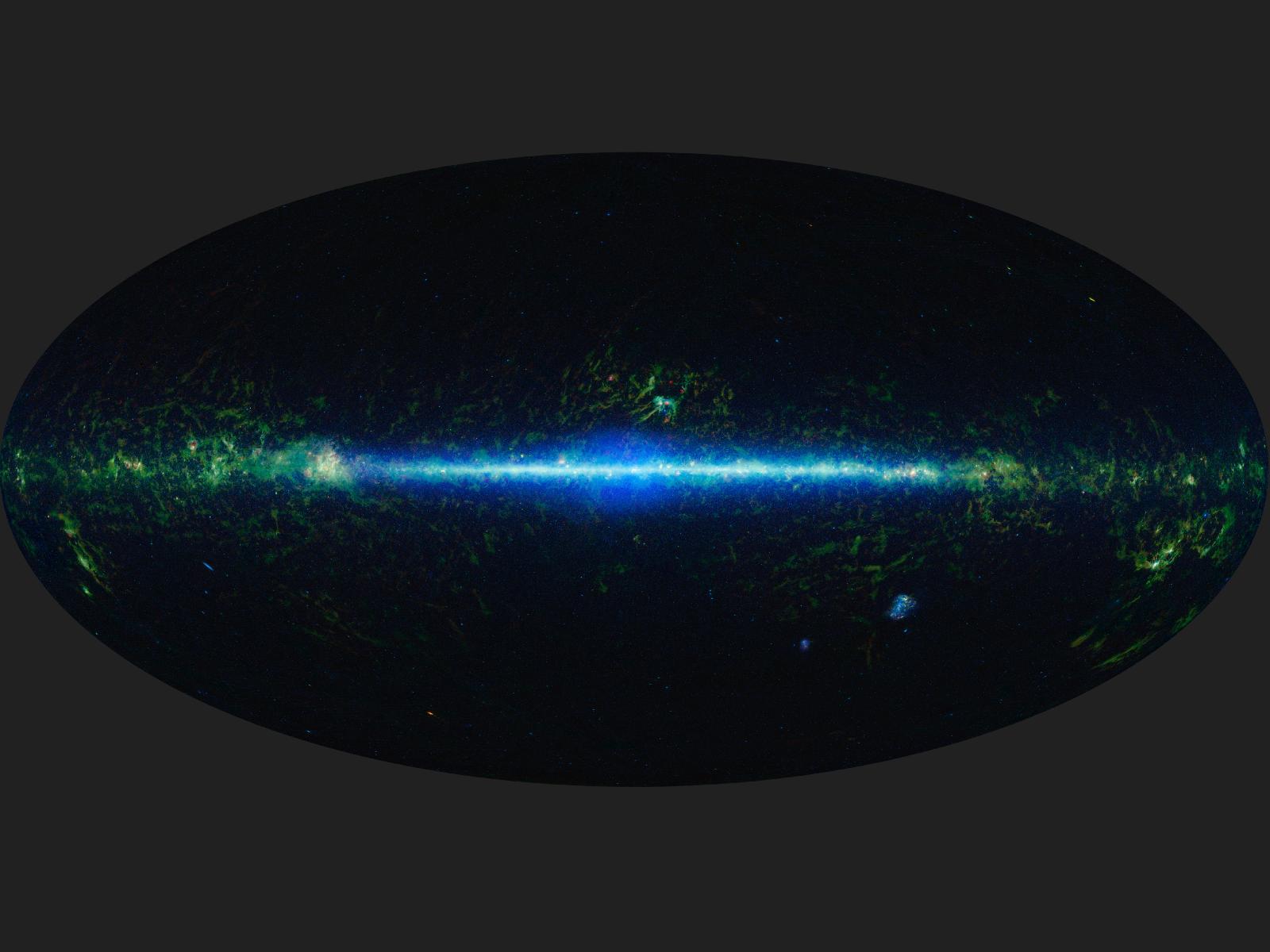
WISE image courtesy of
NASA/JPL-Caltech/UCLA
How do we know that the disk of our own Milky Way contains
spiral arms?
We can see them clearly when we view other galaxies
from far away,
but our Sun lies in the middle of the disk.
Is there any clear evidence for spiral structure?
Since the clouds of gas and dust lying in the disk block
our view of distant portions of the galaxy in the optical,
astronomers have used radio waves --
which can penetrate the clouds --
to examine the far regions of the Milky Way.
We can use radio observations to identify discrete structures
which should act as
tracers
of the spiral arms.
- HII regions -- hydrogen gas ionized by hot, young stars
- Giant Molecular Clouds (GMCs) -- huge clouds of very cool,
molecular hydrogen gas that might, in the future,
turn into star-forming regions
- masers -- very bright clumps of dense gas which occur
in systems which are currently forming stars
Look at the maps of these tracers
in the figures below,
taken from
The Sun is located at (X = 0, Y = 8.5),
and the center of the Milky Way at
(X = 0, Y = 0).
Can you see evidence for spiral structure?
First, look at the position of HII regions.
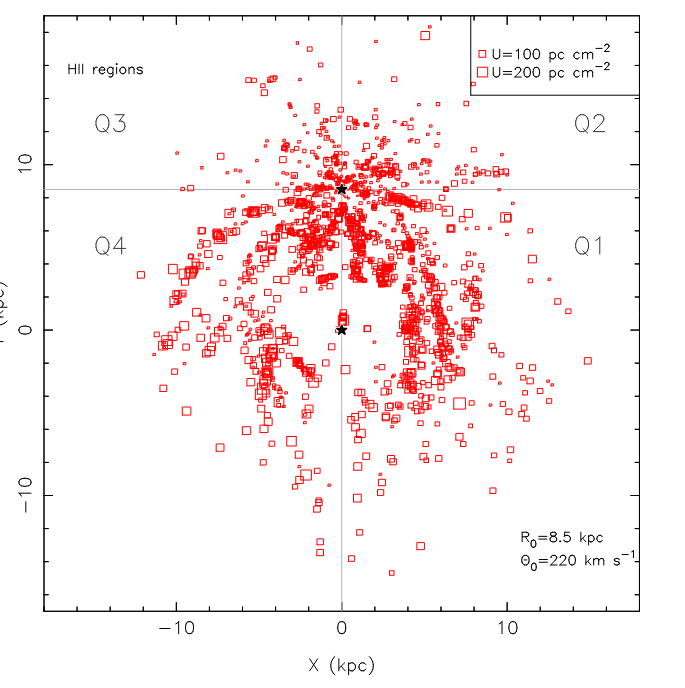
Image taken from Figure 5 of
Hou, L. G., and Han, J. L., A&A 569, A125 (2014)
One model suggests that arms lie here:
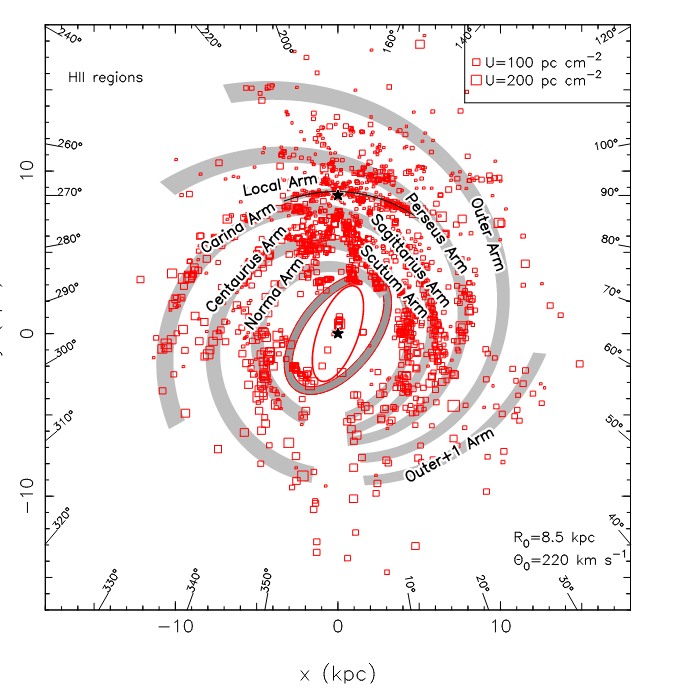
Image taken from Figure 5 of
Hou, L. G., and Han, J. L., A&A 569, A125 (2014)
Will a pattern emerge more clearly if we include
not only HII regions, but also GMCs and masers?

Image taken from Figure 7 of
Hou, L. G., and Han, J. L., A&A 569, A125 (2014)
It probably says a lot that we can't decide
just how many arms the Milky Way contains!
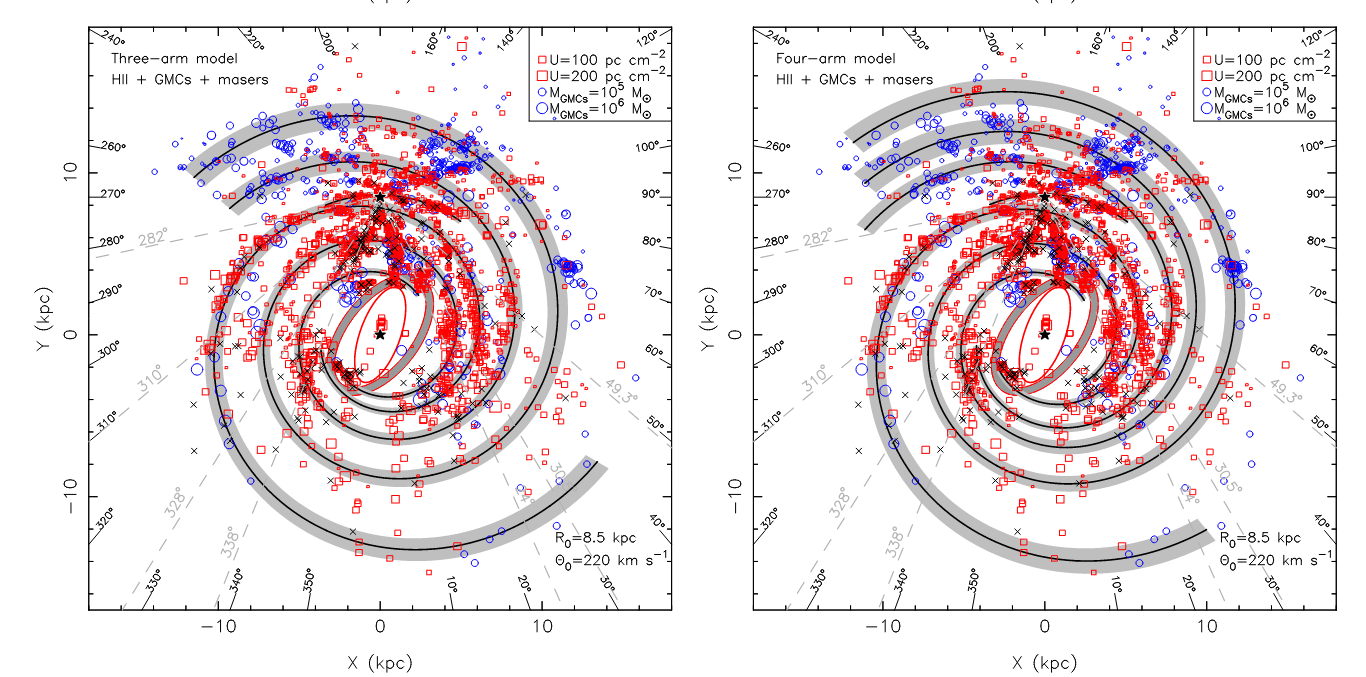
Image taken from Figure 10 of
Hou, L. G., and Han, J. L., A&A 569, A125 (2014)
In the last few years,
Gaia has measured the properties of over a billion
stars in the Milky Way.
Using this gigantic dataset,
and selecting stars of particular types,
we can start to see the spiral arms
directly as clumps of stars (or the voids between them).
Click on the image below to watch an animation
which shows off Gaia's detection
of the spiral arms in the solar neighborhood.
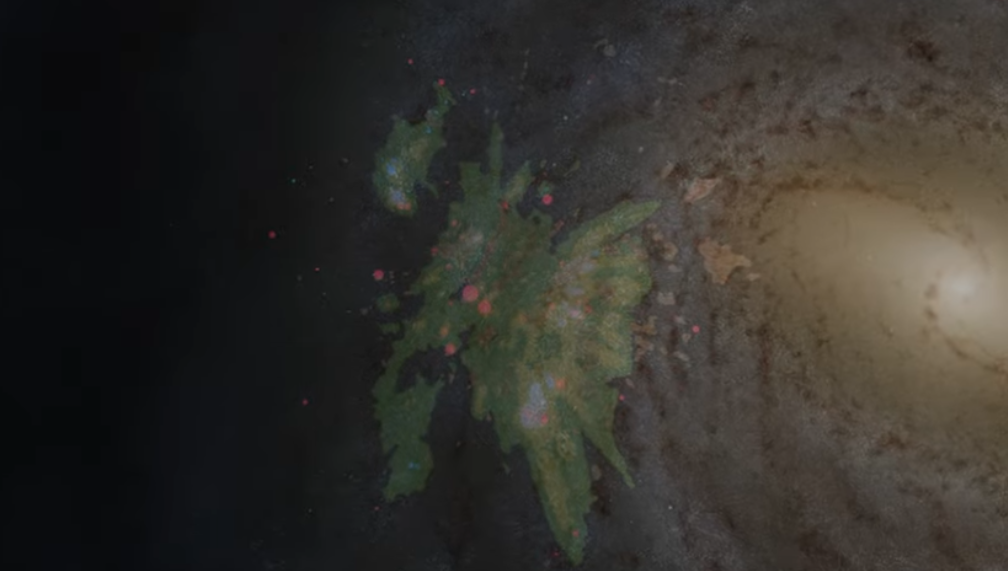
Image and movie courtesy of
ESA/Gaia/DPAC
Using the Gaia database to select the most massive,
and certainly very young,
O and B stars,
we can map out spiral arms in the vicinity of the Sun.

Image courtesy of
Gaia Collaboration, Drimmel et al., arXiv:2206.06207 (2022)
Q: Does the Sun, marked by the cross at (0, 0) in the graph above,
lie inside an arm, or in the space between two arms?
It does appear that we are located
between two spiral arms,
and more than 100 pc from the nearest
substantial HII region.

Image courtesy of
Kevin Jardine,
based on data from the paper
"Gaia Data Release 3: Mapping the asymmetric disc of the Milky Way" by the Gaia Collaboration, Drimmel, R., et al. 2022.
In some other galaxies,
we see evidence for a slight "twist" or warp
in the shape of the disk.
Perhaps the gravitational forces
during a close encounter with another galaxy
produce these distortions.

Image of UGC 3697 courtesy of
NRAO/AUI/NSF, Image copyright J. M. Uson (NRAO), observers L. D. Matthews (CfA), J. M. Uson (NRAO)
Does the plane of our own Milky Way have a similar twist?
Several lines of evidence suggest that it does --
leading to headlines like this:

Headline from
NBC News (Aug 5, 2019)
What is the evidence for these claims?
- The locations of Cepheids
-
The OGLE collaboration studied a set of over 2400 Cepheid variables
in our Milky Way, measuring the distances to each one using
the period-luminosity relationship.
We believe that Cepheids, like almost all stars,
formed from clouds of gas located in the middle of the
disk.
Because Cepheids are relatively young -- the authors
estimate most are between 50 and 250 million years old --
they haven't had time to move from from their birthplaces.
Thus, their current locations mark the position
of the mid-plane of the disk relatively closely.
And look at how that position changes as one selects stars
in different sectors of the galaxy!

Image taken from Figure 2 of
Skowron et al., axXiv 1809.10653 (2019)
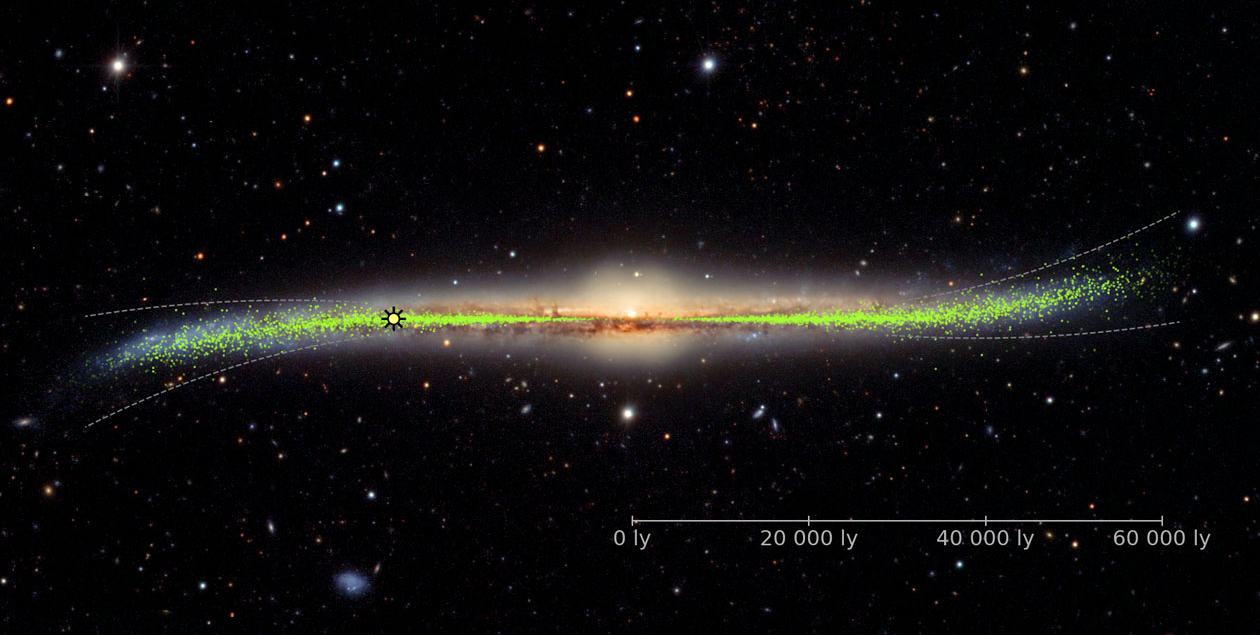
Image courtesy of
J. Skowron/OGLE/Astronomical Observatory, University of Warsaw
- The positions of millions of youngish stars
-
Romero-Gomez et al. (2019)
used Gaia to select two samples of stars that ought to be
relatively young: OB stars, and stars on the Red Giant Branch.
The measured the vertical positions of these stars above
or below the plane of the disk, in the general vicinity of the
Sun.
Below is a map of several models: each symbol shows the location
of the mean of a bunch of stars in the (X, Y) plane of the disk,
and the COLOR of the symbol is related to its VERTICAL position.
Note that a perfectly flat disk will yield a map
which is uniformly grey, indicating no variations in height
from one region to another.
A warped disk, on the other hand, will show a clear pattern.
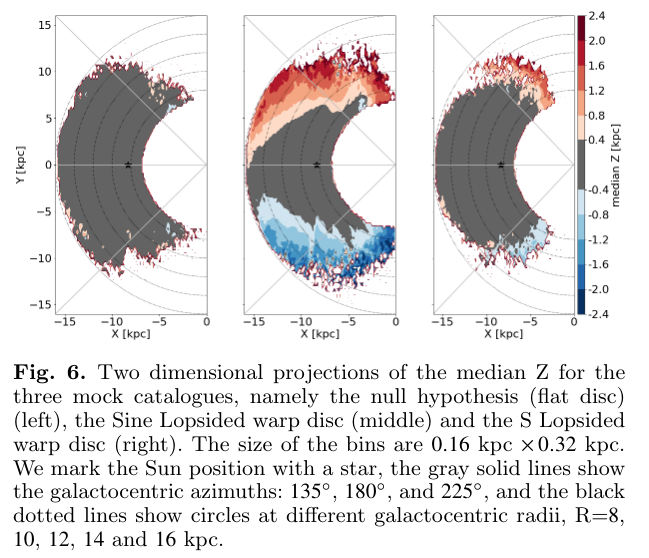
Figure 6 taken from
Romero-Gomez et al. (2019)
The actual Gaia measurements are shown in the figure below.
It's clear that there is a systematic difference between
stars on one side of the Sun and stars on the other side.
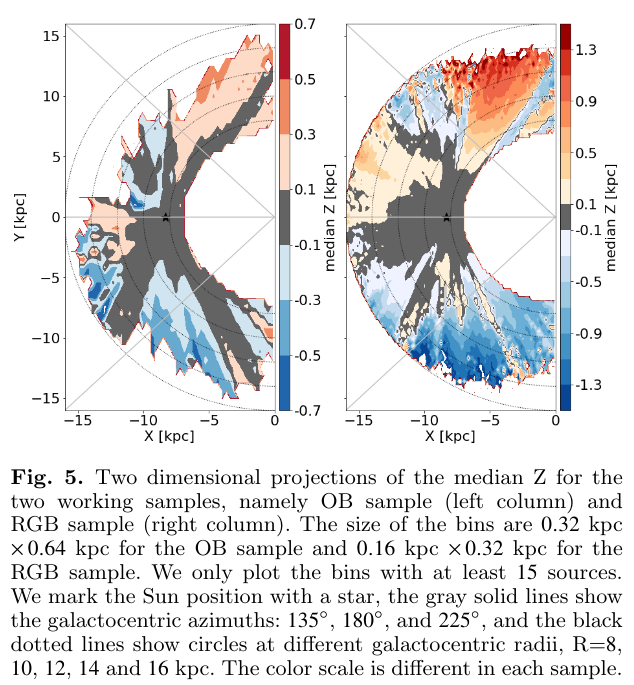
Figure 5 taken from
Romero-Gomez et al. (2019)
Gaia did more than count stars, and measure their distances and luminosities;
for a subset of the brighter stars,
it measured their motions
and the elemental makeup of their outer atmospheres.
That means that we can search through the Gaia dataset
to find clues about the formation and evolution of
our galaxy.
There's a gradient in the metallicity of stars
as one moves from the center outwards:
in general,
the metallicity is highest near the
center and lowest in the outer regions.
However,
that depends on exactly which stars
one measures.
Stars shown in blue below are those closest
to the middle of the plane
of the disk,
while stars shown in red lie at some distance from the plane.

Taken from Figure 13 of
Gaia Data Release 3: Chemical cartography of the Milky Way
by Gaia Collaboration; Recio-Blanco, A., et al.,
A&A (2022) in press.
The different colored lines correspond to samples taken
at the given vertical distances from the plane.
If one examines metallicity as a function of distance
above or below the plane,
then one finds a very clear pattern:
- stars in the middle of the disk have a higher concentration
of heavy elements
- stars far above or below the disk have lower
metallicity
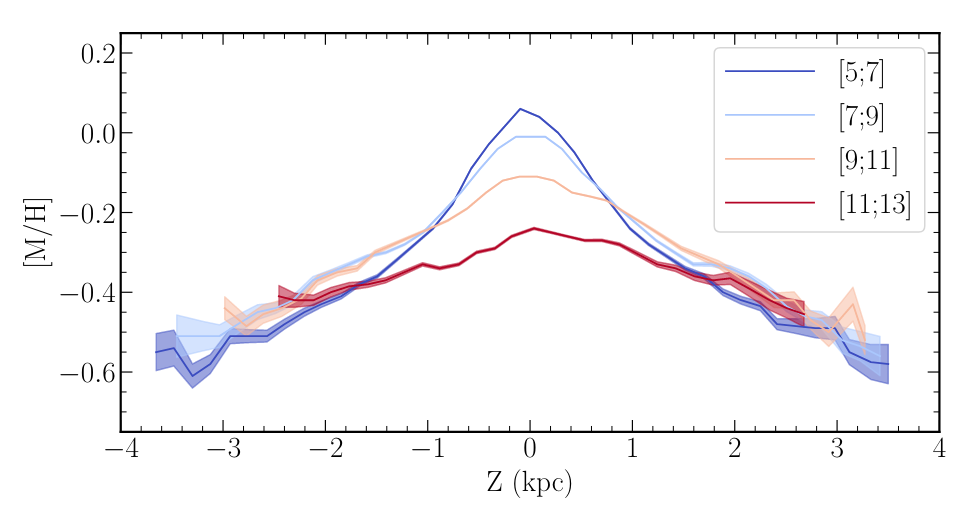
Taken from Figure 13 of
Gaia Data Release 3: Chemical cartography of the Milky Way
by Gaia Collaboration; Recio-Blanco, A., et al.,
A&A (2022) in press.
The different colored lines correspond to samples taken
at the given radial distances from the center of the galaxy.
Q: Can you think of any reason(s) why stars in the very
plane of the disk might have the highest metallicity?
(Hint: where does one find most of the gas and
star-forming regions?)
-
Milky Way dynamics in light of Gaia
is a comprehensive review of the Milky Way's structure and
dynamics, written in late 2024.
-
The Structure, Populations and Kinematics of the Milky Way central and inner Bulge with OGLE, APOGEE and Gaia data
(Han et al., arXiv 2412.00752, 2024)
is a good review of properties of the bulge,
-
Where are the stars?
is a collection of Gaia DR3 highlights from
a number of technical papers
-
The observed spiral structure of the Milky Way
by Hou and Han, A&A, 569, A125 (2019)
- Evidence for the warp in the disk can be found in
-
Gaia Data Release 3: Chemical cartography of the Milky Way
Gaia Collab, Recio-Blanco et al., arXiv:2206.05534 (2022)
 Copyright © Michael Richmond.
This work is licensed under a Creative Commons License.
Copyright © Michael Richmond.
This work is licensed under a Creative Commons License.

 Copyright © Michael Richmond.
This work is licensed under a Creative Commons License.
Copyright © Michael Richmond.
This work is licensed under a Creative Commons License.





















